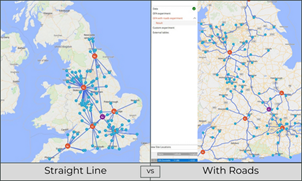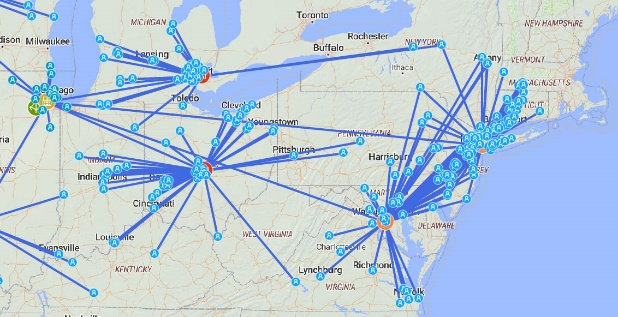Case Study: SimWell Guides a Retailer to Redesign its Supply Chain Network
Overview
A reputed pet and farm supplies retailer was experiencing dramatic growth and believed it was the right moment to rethink its logistics setup to identify the optimal design of its supply chain network to cater to its current and future stores.
.png?width=302&height=220&name=MicrosoftTeams-image%20(59).png)
Being a leader for many years in their region, they had grown invaluable expertise in their customer needs and how to excel in fulfilling them. To maintain and improve their excellent customer service, they knew they would have to identify and evaluate thousands of viable logistics options to find the most optimal one. Their stores serve a wide variety of products manufactured by hundreds of different suppliers. Facing the challenge of shaking up their logistics they knew they would have to walk the fine line between being close to their suppliers to minimize cost and being close to their customers to maximize customer service.
The leaders realized they needed to make a confident decision that considered the logistics and financial intricacies of modern retail supply chains. The team decided to partner up with two outstanding companies to combine the operational and financial knowledge of a very known Supply chain consulting firm and the cutting-edge supply chain technology of SimWell to think outside the box and leave no stone unturned to find the best possible solution to support their operations for the next five years.
Their main objective was to find the optimal location for their distribution centers that would serve their current stores and their expansion into the East of the USA.
Background and Challenge
The retailer company leaders knew that financial analysis in spreadsheets simply could not capture the complexity of their system. Having several hundred suppliers and planning to grow the number of the stores to close to a hundred they needed an experienced team with the latest supply chain optimization tools. 
Logistics optimization problems are difficult since they need to mimic how the goods are moved from the suppliers to the warehouses to the store. Traditional approaches to logistics optimization struggle to consider the complexity of the distance traveled by road and usually calculate distances “as the crow flies”, hence misrepresenting the actual routes that trucks would drive between origin and destination. When a great deal of your operations is located within a peninsula you do not want to use a method that assumes that the trucks can drive over water.
Furthermore, looking for a solution that would work for several years is especially challenging since the proposal needs to strike a balance between the demands of the current operations and the future operations. Every year there are new stores added to the network that need to be considered in the problem.
The potential solution provided for the first year is not likely to be optimal for the total year span considered and for a future stage. Each period there are multiple options to be considered and a powerful tool is needed that can provide those scenarios and produce comparable outputs to make an informed decision.
Solution
To overcome these challenges, the team proposed to build a green field analysis followed by a network optimization exercise that would provide the retailer with the visibility and insights to make a confident decision. SimWell was in charge of conducting these analyses, using the powerful anyLogistix advanced Supply chain analytics software.

Greenfield analysis (GFA) is a mathematical approach to determining the optimal number and location of distribution centers. It considers the location and the volumes of each node - suppliers and stores - to propose how many distribution centers we need in case we want to serve our customers within a determined number of miles. In case we know how many distribution centers we want in our network, green field analysis is able to find the optimal location of those distribution centers to minimize the total distance traveled by our products.
Once we have good candidates for our distribution centers proposed by a GFA, a network optimization (NO) analysis helps us understand in detail what are the differences between those alternatives. Network optimization can project the operations and transportation costs of all the combinations of potential candidates and rank them from the optimal combination to the least optimal.
The retailer’s leaders were interested in investigating two different questions:
- First, how many distribution centers they would need if they aimed to serve all their stores within one day.
- Second, what would be the most optimal location if they aimed to have only two DCs to serve their stores.
Aiming to satisfy those requirements, the SimWell and the Supply chain consulting firm team rolled their sleeves and got to work.
Outcome
The team at SimWell conducted rigorous GFA and NO analyses to provide multiple options to review. Alternating GFA and NO is highly practical when we use anyLogistix, since it allows us to move the model from the GFA model to the NO model at ease and take full advantage of each methodology..png?width=302&height=219&name=MicrosoftTeams-image%20(58).png)
The methodology used by SimWell dramatically enhanced the accuracy of the potential solutions since allowed to compare the optimal results for multiple years. Moreover, the network optimization utilized true road cost calculations, hence showing real distances between nodes and transportation cost associated with those distances.
The combined work of SimWell and the Supply chain consulting firm helped this pet & farm supplies retailer to consider hundred of permutations to finally narrow their options to a few comparable and viable solutions. The detailed information and the enhanced visualizations provided by the results made it easy for them to understand their options and the implications of selecting each one of the scenarios. The team worked iteratively receiving customer feedback to fine-tune the analysis and consider the alternatives that were the most strategically appealing by the retailer.
Start your Supply Chain Network Redesign with SimWell
The SimWell client identified a 10% cost avoidance opportunity with this solution.
When was the last time that you evaluated your logistics network to validate that you are running an optimal set up that allows you to minimize cost and maximize customer satisfaction?
If you want to conduct an analysis that is pain-free and highly rigorous SimWell is here to help you with your supply chain and operations challenges.
See how SimWell can help you taking critical business decisions with confidence on many aspects of supply chain management and operations. On this Supply chain-focused page, you’ll see our expertise in simulating and optimizing supply chains that can make you the hero for your team, your organization, and your community.
What are you waiting for? Let's Talk and see how we can help you.






